The national drive to reduce jail and prison populations is getting an unexpected nudge from the coronavirus pandemic, as many cities and counties across the country try to reduce exposure to the virus in crammed, unsanitary jails. One of their first targets: bail.
In New Orleans, some city judges are reducing some bail amounts to one-tenth of what they would otherwise be to let some people out. In Tulsa, Oklahoma, the jail’s occupancy has reached a record low as people deemed nonthreatening are being released without bail.
To bail-reform advocates across America, this change is a no-brainer: Why incarcerate anyone, pandemic or no, just because they can’t post a cash bond? Their movement looked like a national wave just a couple of years ago, as states from Vermont and New Jersey to Alaska and Georgia rolled out new bail policies to reduce the number of people in jail. These ideas ranged from minor tweaks for only the lowest-level crimes to blanket eliminations of cash bail.
But just a few months ago, before the outbreak, that momentum hit a major roadblock. One of the most high-profile tests of bail reform, in New York state, sparked a political backlash and sent advocates into damage-control mode. In 2019, the New York Legislature passed one of the most progressive bail-reform packages in the United States, abolishing bail for many misdemeanors and nonviolent crimes. Soon after the law went into effect, in January 2020, the New York Police Department released figures showing a spike in crime and pointed the finger at the new, looser bail rules.
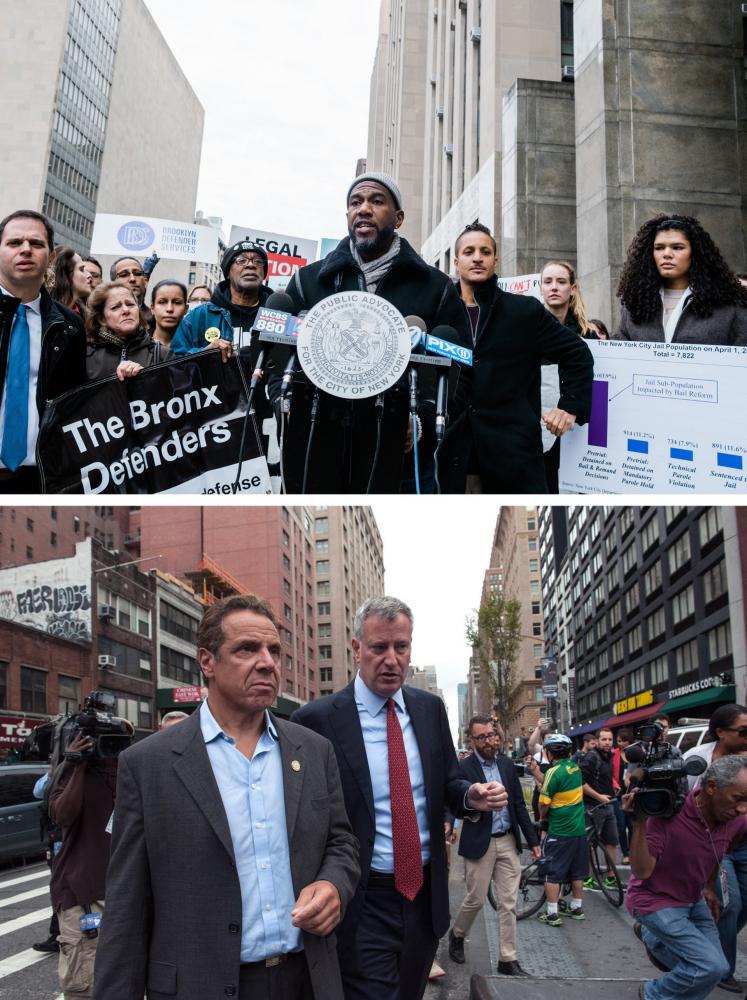
Top: The New York City public advocate, Jumaane Williams, said at a news conference in New York in early January that calls to change new bail laws in the state were premature. Bottom: New York City Mayor Bill de Blasio and New York Governor Andrew Cuomo pictured together in Manhattan. | Stephanie Keith/Getty Images
The crime figures have been disputed, but tabloid headlines and anti-reform prosecutors jumped at the chance to fan the flames, and the new bail policies instantly lost popularity. The percentage of New Yorkers saying the changes would be good for the state dropped from 55 percent last year to 37 percent in January. Prominent politicians, including Governor Andrew Cuomo and Mayor Bill de Blasio, backed a new bill to roll back many of the changes, which passed April 3.
Bail reformers across the country have been paying close attention. “New York is certainly a cautionary tale,” said Alec Karakatsanis, a reform advocate and executive director of the Civil Rights Corps, a criminal justice nonprofit that has filed lawsuits challenging bail in several states.
Now reformers across the country have begun regrouping and tweaking their plans in an effort to learn from past mistakes in bail reform packages, and looking hard at how to keep potential opponents in the fold. “Even if you win a great legislative battle against them,” said Karakatsanis, “it’s not like they'll just go away.”
“New York is certainly a cautionary tale.”
—ALEC KARAKATSANIS, AND EXECUTIVE DIRECTOR OF THE CIVIL RIGHTS CORPS
In Illinois and Colorado, where legislators are working on—but haven’t passed—bail reform bills, proponents have zeroed in on new political tactics like getting more buy-in from police and prosecutors and building in time to educate the courts and the general public to try to stem some of the pushback. Importantly, lawmakers elsewhere are also betting that a quirk unique to New York’s bail system made the state singularly vulnerable to a blowback—and they’re moving ahead in their own states undeterred.
Now, after the debate spurred by Covid-19, they might get their chance to deploy that new and improved playbook. “It was a needed disruption to the direction that we were going in, and further evidence that having so many people in jails, in New York or anywhere, is a threat to public health,” said Scott Roberts, senior criminal justice campaign director at the civil rights advocacy organization Color of Change. “That’s true under normal circumstances, and we see how that can really heighten at a moment's notice.”
Here’s how bail works in most jurisdictions across the country today: Most people who are arrested and charged with crimes must put down a refundable deposit to ensure they’ll show up for their court date instead of skipping town. This means either putting up their own cash, or paying a fee to a commercial bond company that posts bail on their behalf. People who can’t pay bail or a bail bondsman remain in jail.
The commercial side has turned bail into a policy with its own lobby, adding friction to any reform efforts. This is nearly unique to American legal system: Although the concept of bail has been around for centuries, and is expressly mentioned in the U.S. Constitution, the first commercial bail companies in the United States did not emerge until the late 1800s. Today, though many countries continue to use cash bail, the United States, minus four states, and the Philippines are the only ones with a commercial bail industry.
Reform advocates say this creates unequal justice for rich and poor—effectively jailing u-convicted people simply because they don’t have access to money at the right time. Staying in jail has cascading effects: While people are in jail awaiting trial, they can’t work or spend time with their families; they face pressure to plead guilty just to avoid the misery of being locked up. Jailed defendants also often lose their jobs and suffer physical and emotional trauma.
Many countries continue to use bail, but the U.S. and the Philippines are the only ones with a commercial bail industry. | Top: Getty Images; bottom left: Jim Wilson/The New York Times/Redux; bottom right: Andrew Spear for The Washington Post via Getty Images
From a public policy perspective, research suggests that the economic and emotional consequences of being jailed for bail leave people more desperate and unstable than they would have otherwise been, and may actually lead to more, not less crime.
Chicago native Flo, who asked to be identified by his abbreviated name out of concern about finding work, knows those consequences well. After a 2016 arrest for a burglary he attributed to a gambling addiction, he spent about two months in jail, unable to come up with the $7,500 in cash for his bail. He was released after the Chicago Community Bond Fund (CCBF), a nonprofit that raises money to pay bail for defendants, tossed him a lifeline and paid his.
“Jail takes a toll,” Flo said. “The turnout of your case can be dramatically different because you're under pressure. And when you go to court, you’re ready to ‘jump out of the window’ as they say,” and take any plea deal just to go free.
If Flo hadn’t gotten that bail, he wouldn’t have been able to help his wife move when the couple were kicked out of their home; he would have been forced to make court appearances in an orange jumpsuit and shackles rather than a suit and tie. He kept working odd jobs in warehouses and construction, rather than staying in jail and costing taxpayers money. He eventually took a plea deal and served two years after credit for good behavior. If Flo had remained in jail awaiting trial, the data suggests he might also have received a longer sentence: Researchers have found that pretrial detainees have a lot less leverage in bargaining with prosecutors when they are in custody versus out of it.
When it comes to the number of people in local jails, bail isn’t just a side issue: It’s the main driver. There are typically more than 700,000 people in U.S. jails, and about two thirds of them have not yet been convicted of a crime and are there mostly because they couldn’t make bail. It’s an expensive policy: According to a 2014 Brookings Institution study, local corrections systems cost taxpayers at least $22 billion a year. And these numbers are completely separate from people serving sentences in prisons.
On these moral and public policy grounds, activist groups and legislators in many parts of the country have been pushing to eliminate cash bail entirely. Some seek to replace it with algorithmic risk assessments, electronic monitoring and other technical innovations. Many just want to see as many people released pretrial as possible, and think the criminal justice system shouldn’t try to predict what people who are presumed innocent are or are not likely to do if released. Virtually all reform advocates seek to release defendants on the “least restrictive possible means” that ensure they show up for court—sometimes simply a signed promise that they will. Dozens of nonprofits have popped up to pay money bonds on behalf of pretrial defendants in a push to empty jails.
Few efforts represented as sweeping a change as New York’s reform. The law, which passed in April 2019, limited the number of crimes for which judges could set bail, mostly to violent felonies. Almost everyone else—those who make up 90 percent of arrests in the state—could walk free while they waited for their trial date, though judges could impose strict monitoring conditions. For the first three months the law was in effect, from January through March, New York’s jail population dropped sharply: At the end of 2019, the jail population across the state was close to 20,000; for the first three months of 2020, it was around 15,000 and continuing to shrink.
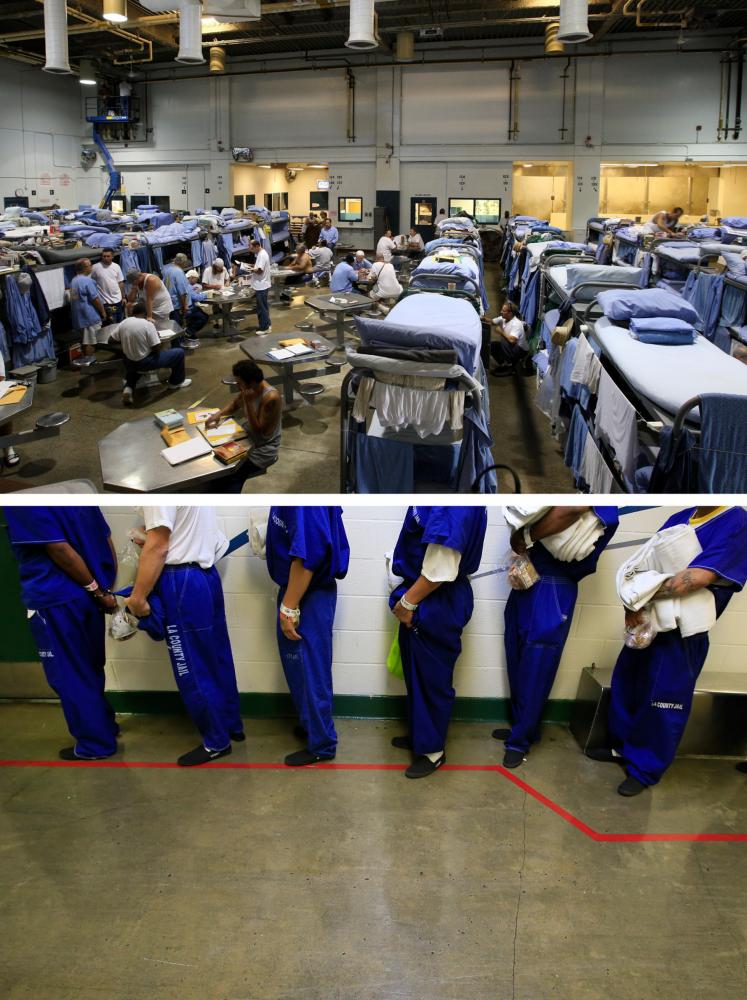
There are around 700,000 people in U.S. jails, and two-thirds of them have not been convicted of a crime. | Top: Justin Sullivan/Getty Images; bottom: Brian Vander Brug/Los Angeles Times via Getty Images
And then came news of a crime spike. A number of hate crimes had shaken New York over the holidays, including a woman who was arrested three times for assaulting Orthodox Jewish women in one week in Brooklyn; outlets noted that she had been released from jail under the state’s new bail reform laws. In early March, the NYPD released a report showing that crime in February 2020 was up 22.5 percent compared with February 2019. In the report, the department explicitly blamed the uptick on criminal justice reforms, including the bail reform law. According to the department, in the first two months of the year, 482 people who had been arrested on charges where cash bail was prohibited went on to commit 846 new crimes.
The reported spike got wall-to-wall coverage in New York’s tabloids, with headlines like “No Bail Madness” and “Revolving Door Lunacy.” Legal aid groups disputed those numbers, pointing out that arraignments—the court appearances where bail is generally set—were down 20 percent at the same time, and suggested that perhaps officers were making bad arrests to make the stats look bad and that prosecutors had to ultimately toss out those charges.
Politically, though, the damage was done. Prosecutors joined the police in blaming bail reform, and the governor, who had supported the measure, vowed not to sign any 2020 budget that didn’t reform the reforms. Dermot Shea, the New York City police commissioner, took to the New York Times with an op-ed headlined “New York’s New Bail Laws Harm Public Safety.” The Senate minority leader in New York, John J. Flanagan of Long Island, issued frequent news releases, connecting grisly crimes to recent reforms.
Bail advocates were furious. As they saw it, the policy hadn’t been in place long enough to know what the impact on crime—or anything else—might be. “If we had been able to give those changes time and space to take hold, I’m very confident that we would have seen how right we were,” said Scott Hechinger, a New York bail reform advocate. “The problem was, we didn’t have patience.” Instead, by Hechinger’s read, fearmongering took over. Under the old system those same individuals could, and sometimes did make bail, get out, and commit a new crime—but news reports did not routinely highlight such cases. According to an analysis by a pair of City Council members in Queens, people released under the new law made up, at most, 7 percent of the increase in the crime rate. A group of 45 law professors signed a letter to the New York Press Club calling on the city’s media to provide “accurate and objective context” in coverage of criminal justice reforms, saying the stories were designed to stoke panic and calling them “Willie Horton-like claims.”
But these advocates couldn’t stop the rollback. In early April, the Legislature amended the bail reform law with a number of changes set to take effect in July. The changes expand the number of crimes for which judges can set bail to include burglary, vehicular assault and sex trafficking, among others, and crimes committed by a “persistent felony offender.” And while advocates were crushed by the setback, the move was still insufficient for the most fervent opponents of the law. “This approach does not come close to addressing the problems w/ the law. What about serious offenses that didn't make the cut?” the Police Benevolent Association, a union for NYPD officers, tweeted in response to the changes in early April.
In other states, some of which had seen years of groundwork on new bail laws, reform advocates watched this backlash and snapped to attention.
Colorado is one state where the lessons of New York could reshape the bail debate. Governor Jared Polis recently told a justice system forum that he would “like to see Colorado lead the nation in criminal-justice reform,” and in 2019, state lawmakers considered dozens of crime and justice bills—more than some lawmakers said they’d seen in any single legislative session.
One bill that failed during that session, though, would have eliminated cash bail for low-level crimes: It passed the state House but died without a vote in the Senate. Lawmakers there are hopeful about reviving the bill this year and see lessons in the way the reforms played out in New York.
“We’re trying to avoid the pendulum effect,” said Democratic Colorado state Senator Mike Weissman, who was helping draft the law. “If you’re making a reform change for a year or two, and then, you have that revert when political winds change, then you're not really doing what you wanted. So I think most people around here are trying to dig in deeper and harder, get it right the first time and not have it swing back.”
Supporters there are also quick to note that, in a state with one-third the population of New York, many of the main actors in the justice system know one another, which, some hope, might make the road to reform a little smoother. Several Colorado lawmakers pointed to the broad coalition assembled to help guide the bail reform proposal, including high-ranking judges, prosecutors, police chiefs and sheriffs. While their support is far from unanimous, it’s more buy-in than existed in New York.
“In many ways you make a bill a lot better by having it fail several times, by being forced to work on it. You get to see what it is that causes everyone the most pain.”
—MATT SOPER, REPUBLICAN STATE REPRESENTATIVE AND SPONSOR OF THE BILL
Matt Soper, a Republican state representative in Colorado and sponsor of the bill last year, pointed to the defeat last session as an opportunity to fine-tune the proposal, adding concessions that could appease some of those powerful judicial system actors. Soper highlighted tweaks in the 2020 version of the legislation that include making it a crime for a defendant released before trial to miss a court date. “There’s a lot of those little moving parts here that you don't see in New York or California,” Soper said. California passed a law abolishing all cash bail in 2018, but its implementation has been delayed pending the outcome of a state referendum on the changes in the fall.
“In many ways you make a bill a lot better by having it fail several times, by being forced to work on it. You get to see what it is that causes everyone the most pain,” Soper said. He added that the Colorado package will also set aside time and money for training judges and other members of the courts on the new law, something critics have said the New York reform did not sufficiently account for.
“I think that New York situation highlights the extreme importance of allowing time for implementation,” said Amber Widgery, a program principal with the National Conference of State Legislatures. She pointed to New Jersey as an example of how to make reforms last. The state virtually eliminated cash bail in 2017, has seen jail populations drop by about 30 percent and hasn’t seen nearly the same backlash as in New York.
The rollout in New Jersey included training for judges and their staff on the technical aspects of the new law, like how to use new computerized risk assessment tools, and on the changes to state court rules. The state also built a new pretrial services department to orchestrate and track pretrial release. Widgery said those efforts across a 2½ year span before the new law went into effect helped to create a “culture change” within the state judiciary. “That is something that legislators who are eyeing reforms in this coming year are paying a lot of attention to,” Widgery said.
And in general, lawmakers in Illinois and Colorado are feeling confident that they won’t face the same kind of backlash, arguing that New York has a unique legal environment that contributed to the blowback. Thanks to a 1971 law, New York is the only state in the country where judges don’t have the authority to consider a person’s possible “dangerousness” in determining the conditions of their release before trial. When reform negotiations in the state began and the door was opened to modifying that system, some lawmakers wanted to add dangerousness as a sanctioned factor for pretrial release, in exchange for the total abolition of bail in the state. Progressive reformers bristled—arguing that too often, judges ascribe dangerousness in ways that amplify the racial discrimination that pervades the justice system. Ultimately, they pursued a compromise that did not add dangerousness but preserved bail only for the most serious crimes.
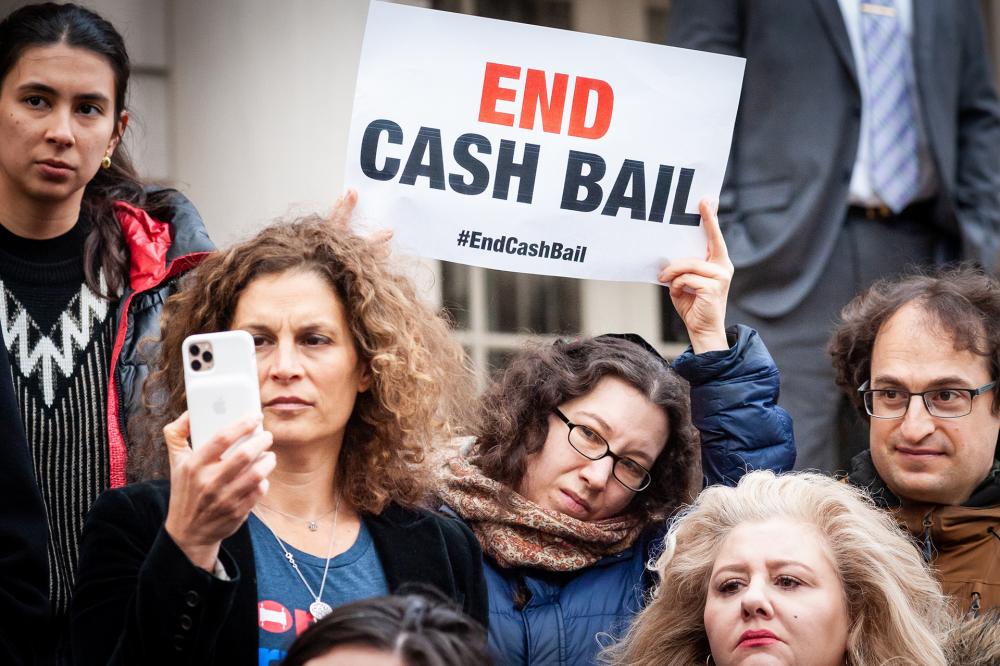
A spate of hate crimes over the holidays and at the beginning of 2020 helped erode support for the bail reform law. Above, a coalition of Jewish organizations, rabbis and elected officials express their continued support of the reforms at a rally at City Hall on January 16. | Gabriele Holtermann-Gorden/Sipa USA
This made it easy for reform opponents in New York to argue that dangerous criminals were being let out of jail along with the nonviolent ones, and that the reforms had served to hamstring judges’ ability to keep the public safe.
In states like Colorado and Illinois, where judges have long had the discretion to consider dangerousness, the starting point for reform negotiations look different. The Illinois Coalition to End Money Bond, for instance, of which the Chicago bail fund is a member, accepts the possibility of preventative detention on a case-by-case basis “to ensure community safety and the defendant’s appearance in court” as a “last resort.”
Sharlyn Grace, executive director of the Chicago bail fund and an advocate of bail reform in that state, said she’s not at all discouraged by the experiment in New York. With the support of Illinois Gov. J.B. Prizker and legislators like state Senator Robert Peters, she expects the state to pass substantial bail reforms this year, or whenever the Legislature returns to business after the coronavirus crisis.
These differences from New York, and the more successful test cases like New Jersey, had advocates pushing forward with bail reform changes with confidence in their own states in recent weeks. And now, those seeking the maximum possible relief for poor pretrial detainees may just have a new wind at their back, one blowing a lot harder than the chill of New York’s backlash. When I asked Stan Hilkey, executive director of the Colorado Department of Public Safety, if Covid-19 might change the bail reform debate, he said recently released inmates could make a good case.
“I think if you have evidence that someone is a danger to somebody, present that evidence and we’ll go from there.”
—ROBERT PETERS, ILLINOIS STATE SENATOR AND BAIL REFORM PROPONENT
“If they show up for court and don’t commit any more crime or victimize people,” he said, “the data in the coming months and years could write a very supportive story for Colorado’s efforts to reduce crime and incarceration.”
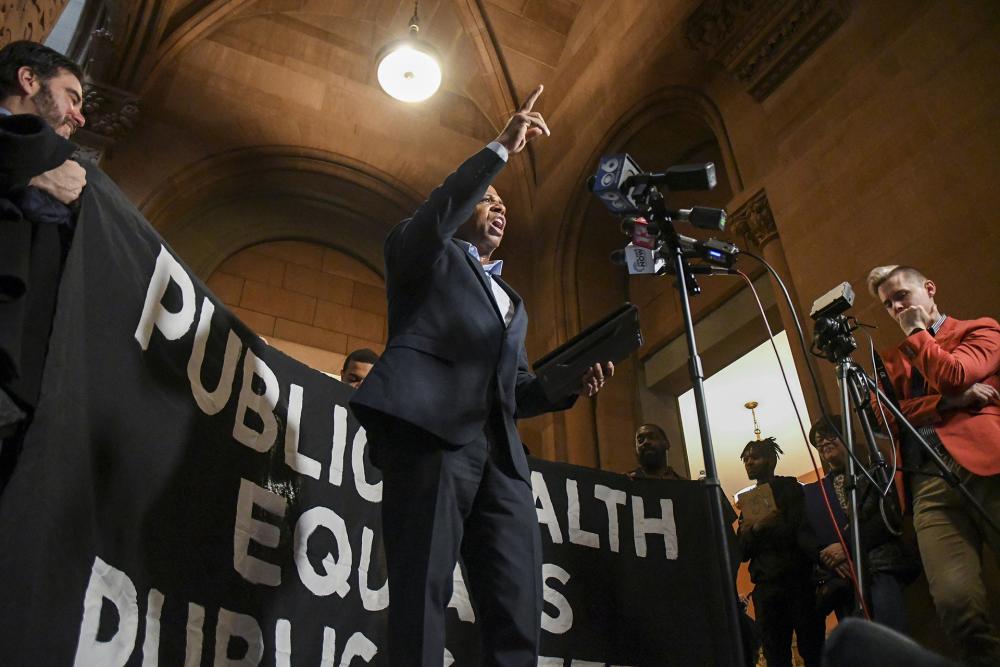
Activist Marvin Mayfield speaks out against rolling back the reform law at a rally at the state capitol in Albany on February 4. | Cindy Schultz/The New York Times
Peters, the Illinois state senator, said the coronavirus pandemic, and the threat to people in jails, strengthens the case for ending cash bond. In his Cook County district, nearly 400 people in jail have tested positive for the virus as of Sunday, out of a population around 5,500, far outpacing the rate of infection in the city. Six detainees so far have died after testing positive.
“When we come back in session, advocates can look at how many people died in the jail who should have never been in there.”
Jamiles Lartey is a New Orleans-based staff writer for the Marshall Project. Previously, he worked as a reporter for the Guardian covering issues of criminal justice, race and policing.

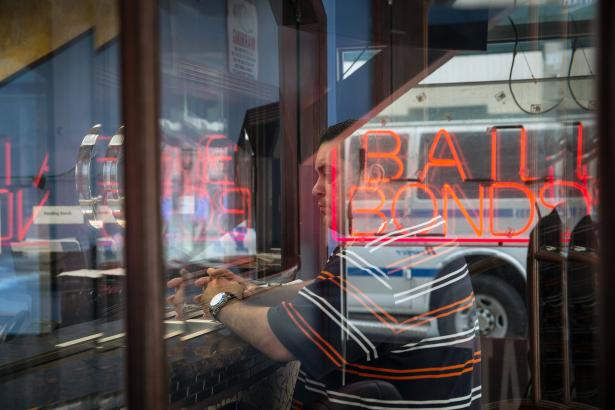
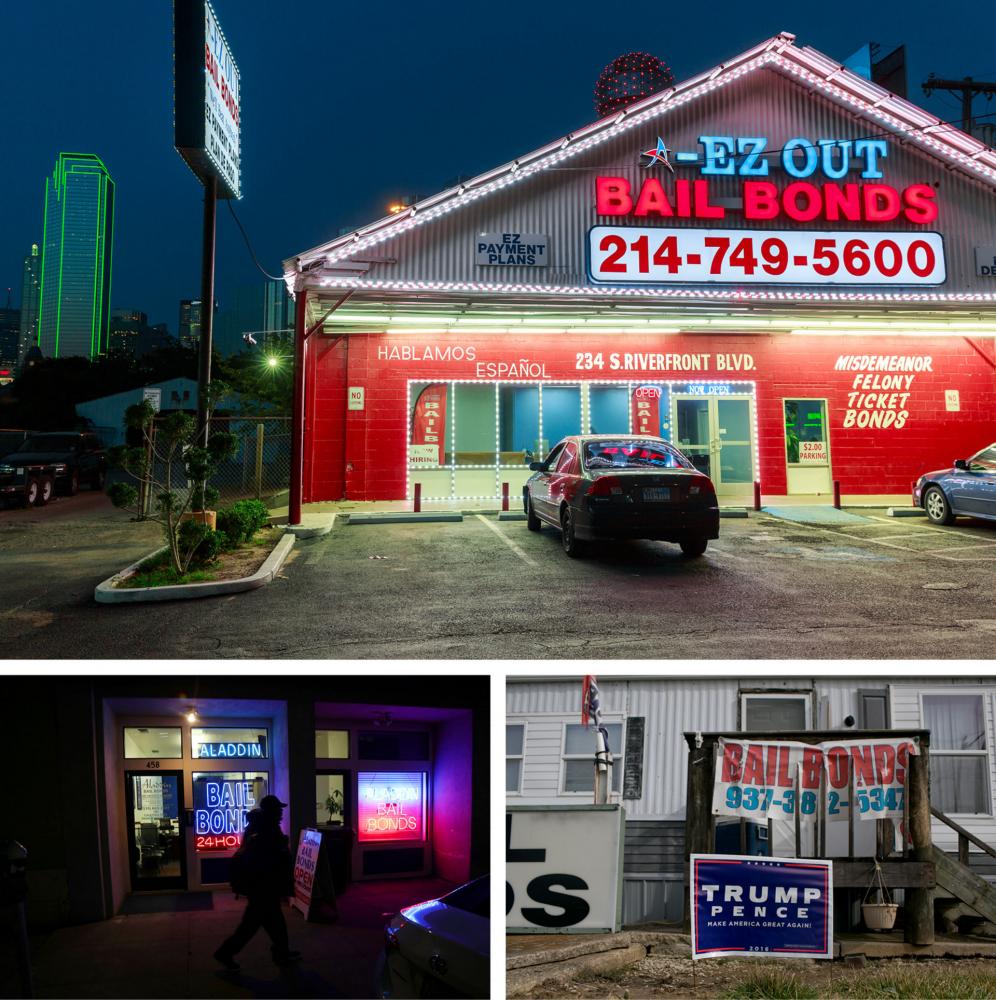
Spread the word